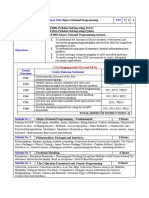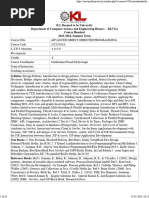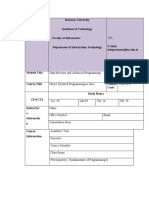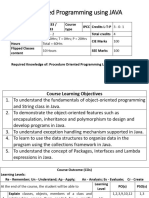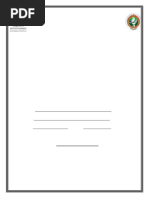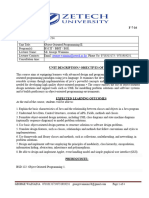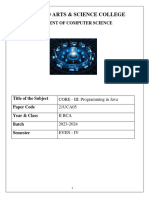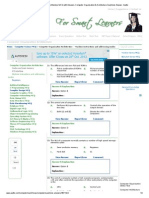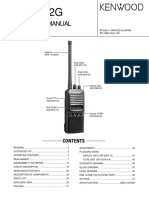0 ratings0% found this document useful (0 votes)
5 viewsCSE2005_OBJECT-ORIENTED-PROGRAMMING-USING-JAVA_ETH_4.1_15_CSE2005 - Object Oriented Programming using JAVA_Revised-4.1 (B.Tech-UC)
The document outlines the course structure for 'Object Oriented Programming using JAVA' (CSE2005), including prerequisites, objectives, and outcomes. It details the course modules covering fundamental OOP concepts, inheritance, polymorphism, exception handling, collections framework, and concurrent programming, along with lab exercises for practical implementation. The evaluation criteria include theory assessments, digital assignments, and laboratory performance.
Uploaded by
Ajay Prakash SinghCopyright
© © All Rights Reserved
Available Formats
Download as DOCX, PDF, TXT or read online on Scribd
0 ratings0% found this document useful (0 votes)
5 viewsCSE2005_OBJECT-ORIENTED-PROGRAMMING-USING-JAVA_ETH_4.1_15_CSE2005 - Object Oriented Programming using JAVA_Revised-4.1 (B.Tech-UC)
The document outlines the course structure for 'Object Oriented Programming using JAVA' (CSE2005), including prerequisites, objectives, and outcomes. It details the course modules covering fundamental OOP concepts, inheritance, polymorphism, exception handling, collections framework, and concurrent programming, along with lab exercises for practical implementation. The evaluation criteria include theory assessments, digital assignments, and laboratory performance.
Uploaded by
Ajay Prakash SinghCopyright
© © All Rights Reserved
Available Formats
Download as DOCX, PDF, TXT or read online on Scribd
You are on page 1/ 3
Course Title Object Oriented Programming using
Course Code: CSE2005 TPC 3 2 4
JAVA
Version No. 4.1
Course Pre-requisites/
CSE1022 – Introduction to Programming
Co- requisites
Anti-requisites (if any) CSE2015,SWE2005
1. To design the concepts of object-oriented, event driven, and concurrent
programming paradigms and develop skills by using these paradigms in
Java.
2. To analyze, design the principals of inheritance, dynamic polymorphism
Objectives:
and interfaces.
3. To learn writing a computer program to solve specified problems.
4. To enable using the Java SDK environment to create, debug and run
simple applications.
CO's Mapping with PO's and PEO's
Course
Course Outcome Statement PO's / PEO's
Outcomes
Design the structure of the Java programming
CO1 PO1 / PEO4
language
Identify classes, objects, members of a class and
CO2 PO1 / PEO4
relationships among them needed for a specific problem
Develop applications using packages, interfaces and also
CO3 PO2, PO11 / PEO2
database connection
Develop Java programs to implement error handling
CO4 PO2, PO5 / PEO2
techniques using exception handling
Develop applications using Object Oriented Programming
CO5 PO3/ PEO3
principals and proper programming structure
Develop and understand multithreaded applications with
CO6 PO2, PO3, PO5 / PEO3
synchronization
TOTAL HOURS OF INSTRUCTIONS: 45
a
Module No. 1 Object-Oriented Programming – Fundamentals 7 Hours
Features of OOP – Data types, variables, Array, Operators, String function, Control statements, Objects
and Classes in Java – Defining Classes – Methods - Access Specifiers – Static Members – Constructors,
this Keyword-Encapsulation.
Module No. 2 Inheritance and Polymorphism 8 Hours
Inheritance: Inheritance Hierarchies, super keyword – final keyword-final classes and methods.
Polymorphism: dynamic binding, method overriding. Abstraction-abstract classes and methods. The
Object class –– Object Cloning – Inner Classes-Garbage Collection - Finalize Method.
Module No. 3 Packages and Interfaces 8 Hours
Packages and Interfaces -Interfaces - Interfaces vs. Abstract classes, defining an interface, implementing,
Inner classes - uses of inner classes, local inner classes, anonymous inner classes, static inner classes.
interfaces - extending interfaces.
Module No. 4 Exception Handling 6 Hours
Exceptions – Exception Hierarchy-Throwing and Catching Exceptions-Multiple Catch Clause-Nested Try
statement- throw-throws-finally- Built in exceptions - User Defined Exceptions.
Module No. 5 The Collections Framework and Generic Programming 9 Hours
Collection, overview, Collection interface –List, Set, Map, Collection Classes- Array List, HashSet,
HashMap- Using an Iterator- For-Each-Comparators, Wrapper classes. Motivation for Generic
Programming – Generic Classes and Methods – Bounded Types –Wildcard Arguments –Generic
Constructors and Interfaces.
Module No. 6 Concurrent Programming 7 Hours
Multi-Threaded Programming – Process Vs Thread - Thread Life Cycle - Thread class – Runnable
interface- Thread Creation- Interrupting Threads – Thread States – Thread Properties –-Thread Control
and Priorities - Inter Thread Communication -Thread Synchronization – Synchronization.
Text Books
1. Herbert Schildt, “Java: The Complete Reference”, McGraw-Hill Education, Twelfth edition,2021.
References
1. Kathy Sierra, Bert Bates, Trisha Gee, “Head First Java: A Brain-Friendly Guide”, Shroff Publishers
& Distributor, Third Edition, June 2022.
2. Deitel “Java- How to Program:” Pearson Education, Asia, Eleventh edition 2018.
3. George Reese “Database Programming with JDBC & Java”, O'Reilly Media, Inc. ,Second Edition
2000 .
Lab Exercises
1. Write a Java Program to demonstrate control statements.
2. Write a Java Program to implement array of objects.
3. Write a Java Program to demonstrate String and String function.
4. Write a Java Program to define a class, describe its constructor, overload the Constructors
and instantiate its object
5. Write a Java Program to define a class, define instance methods for setting and Retrieving
values of instance variables and instantiate its object
6. Write a Java Program to define a class, define instance methods and overload them and
use them for dynamic method invocation
7. Write a Java Program to implement Wrapper classes and their methods.
8. Write a Java Program to implement inheritance and demonstrate use of method overriding.
9. Write a Java Program to implement multilevel inheritance by applying various access
controls to its data members and methods.
10. Write a Java program to demonstrate use of implementing interfaces.
11. Write a Java program to implement the concept of importing classes from user defined
package and creating packages
12. Write a program to implement the concept of threading by implementing Runnable
Interface
13. Write a Java program to implement the concept of Exception Handling using predefined
exception.
14. Write a Java program to implement the concept of Exception Handling by creating user
defined exceptions.
15. Write a Java program using Collections
16. Write a Java Program using Generics
17. Write a Java Program to implement multi-threading.
18. Write a Java Program to implement Synchronization.
19. Write a Java Program to implement inter thread communication.
20. Write a java Program to demonstrate JDBC connection.
Course Type Embedded Theory and Lab(ETL)
Theory 75%
Continuous Assessment Test-1 15
Continuous Assessment Test-2 15
Mode of Evaluation
Digital Assignments/Quizzes 30
Final Assessment Test 40
Laboratory 25%
Modified By
Dr. Prabha Selvaraj and Dr. Gopikrishnan S
Recommended by the
14th BoS, 11.05.2024
Board of Studies on
Date of Approval by
12th Academic Council, 25.05.2024
the Academic Council
You might also like
- BSCS OBE Syllabus For Computer Programming 1No ratings yetBSCS OBE Syllabus For Computer Programming 17 pages
- WINSEMFRE2024-25_SWE2005_ETH_AP2024255000728_2025-01-28_Reference-Material-INo ratings yetWINSEMFRE2024-25_SWE2005_ETH_AP2024255000728_2025-01-28_Reference-Material-I3 pages
- Course Code: Course Title TPC Version No. Course Pre-Requisites/ Co-Requisites Anti-Requisites (If Any)No ratings yetCourse Code: Course Title TPC Version No. Course Pre-Requisites/ Co-Requisites Anti-Requisites (If Any)4 pages
- PC 101 - INFT - Program Core - Object Oriented Programming Methodology (OOPM) - Java Programing - FE - SEM 2No ratings yetPC 101 - INFT - Program Core - Object Oriented Programming Methodology (OOPM) - Java Programing - FE - SEM 26 pages
- Method of Assessment: Internal: Mid Semester Theory Examination (Pen Paper Test)No ratings yetMethod of Assessment: Internal: Mid Semester Theory Examination (Pen Paper Test)22 pages
- CE505 - Object Oriented Programming With JAVANo ratings yetCE505 - Object Oriented Programming With JAVA3 pages
- Object Oriented Technique Using Java (Theory and Lab)No ratings yetObject Oriented Technique Using Java (Theory and Lab)6 pages
- Object Oriented Programming With Java 8 PG-DBDA September 2023No ratings yetObject Oriented Programming With Java 8 PG-DBDA September 20235 pages
- CS2203 Objected Oriented Programming L-T-P-C 4-0-0-4: Externals: 60marks Internals: 40marksNo ratings yetCS2203 Objected Oriented Programming L-T-P-C 4-0-0-4: Externals: 60marks Internals: 40marks4 pages
- Course-Outline - Object Oriented ProgrammingNo ratings yetCourse-Outline - Object Oriented Programming3 pages
- Programme: Diploma Programme in IF / CM Course: Java Programming Course Code: 1441 Prerequisite: Nil Teaching & Examination SchemeNo ratings yetProgramme: Diploma Programme in IF / CM Course: Java Programming Course Code: 1441 Prerequisite: Nil Teaching & Examination Scheme5 pages
- MODULE 3 - AJAVA - 21CS642-NOTES-Nithin Kurup-AIMLNo ratings yetMODULE 3 - AJAVA - 21CS642-NOTES-Nithin Kurup-AIML47 pages
- 24CSE102_Object Oriented Programming_ 1st Sem_CPSNo ratings yet24CSE102_Object Oriented Programming_ 1st Sem_CPS3 pages
- Module 1-Ajava 21CS642 - Notes-Nithin Kurup-AimlNo ratings yetModule 1-Ajava 21CS642 - Notes-Nithin Kurup-Aiml43 pages
- Java Lab Manual Jan-June 2023 for StudentNo ratings yetJava Lab Manual Jan-June 2023 for Student11 pages
- Java Algorithms for Beginners: A Practical Guide with ExamplesFrom EverandJava Algorithms for Beginners: A Practical Guide with ExamplesNo ratings yet
- Download full (Ebook) Logarithmic Voltage-to-Time Converter for Analog-to-Digital Signal Conversion by Mauro Santos, Jorge Guilherme, Nuno Horta ebook all chapters100% (7)Download full (Ebook) Logarithmic Voltage-to-Time Converter for Analog-to-Digital Signal Conversion by Mauro Santos, Jorge Guilherme, Nuno Horta ebook all chapters65 pages
- 4b - Introduction To Basic Amplifier Circuits and ParametersNo ratings yet4b - Introduction To Basic Amplifier Circuits and Parameters25 pages
- Computer Organization Architecture MCQ - Avatto-Pahe15No ratings yetComputer Organization Architecture MCQ - Avatto-Pahe152 pages
- TAB E 7.0" LTE REV0.3: Samsung Confidential Samsung ConfidentialNo ratings yetTAB E 7.0" LTE REV0.3: Samsung Confidential Samsung Confidential10 pages
- Computer Science - Introduction To Java ISC Notes100% (3)Computer Science - Introduction To Java ISC Notes10 pages
- Concurrency: Deadlock and Starvation: Ninth Edition, Global Edition by William StallingsNo ratings yetConcurrency: Deadlock and Starvation: Ninth Edition, Global Edition by William Stallings69 pages
- NSX-T Reference Design Guide Version 2.0No ratings yetNSX-T Reference Design Guide Version 2.0246 pages
- COBOL Basics Questions and Answers - SanfoundryNo ratings yetCOBOL Basics Questions and Answers - Sanfoundry2 pages
- Hydraulic Valve For The Control of Hazardous MovementsNo ratings yetHydraulic Valve For The Control of Hazardous Movements3 pages




